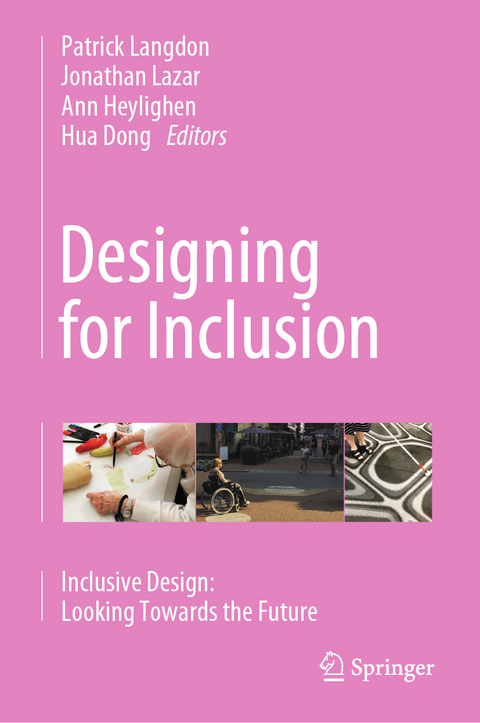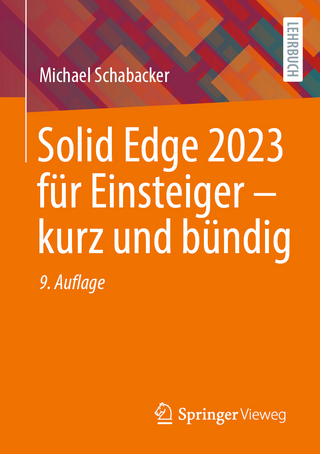
Designing for Inclusion
Springer International Publishing (Verlag)
978-3-030-43864-7 (ISBN)
This proceedings book presents papers from the 10th Cambridge Workshops on Universal Access and Assistive Technology. The CWUAAT series of workshops have celebrated a long history of interdisciplinarity, including design disciplines, computer scientists, engineers, architects, ergonomists, ethnographers, ethicists, policymakers, practitioners, and user communities. This reflects the wider increasing realisation over the long duration of the series that design for inclusion is not limited to technology, engineering disciplines, and computer science but instead requires an interdisciplinary approach. The key to this is providing a platform upon which the different disciplines can engage and see each other's antecedents, methods, and point of view.
This proceedings book of the 10th CWUAAT conference presents papers in a variety of topics including
- Reconciling usability, accessibility, and inclusive design;
- Designing inclusive assistive and rehabilitationsystems;
- Designing cognitive interaction with emerging technologies;
- Designing inclusive architecture;
- Data mining and visualising inclusion;
- Legislation, standards, and policy in inclusive design;
- Situational inclusive interfaces; and
- The historical perspective: 20 years of CWUAAT.
CWUAAT has always aimed to be inclusive in the fields that it invites to the workshop. We must include social science, psychologies, anthropologies, economists, politics, governance, and business. This requirement is now energised by imminent new challenges arising from techno-social change. In particular, artificial intelligence, wireless technologies, and the Internet of Things generate a pressing need for more socially integrated projects with operational consequences on individuals in the built environment and at all levels of design and society. Business cases and urgent environmental issues such as sustainability and transportation should now be a focus point for inclusion in an increasingly challenging world. This proceedings book continues the goal of designing for inclusion, as set out by the CWUAAT when it first started.
Patrick Langdon is an experimental psychologist who has contributed to cognitive science, artificial intelligence, robotics, and psychophysics. Now at the Cambridge University Engineering Design Centre, his most recent research has been in inclusive user-centred design, interaction design, prior experience, and multimodal interface profiling from cognitive modelling. Dr. Langdon was primary author and co-investigator of the successful EPSRC EQUAL "i~design 3" consortium project; "Extending Active Living Through More Effective Inclusive Design" (2006-2011), which he also managed. He was invited to join phase 2 of the (EPSRC/DST) India-UK Advanced Technology Centre, a centre of excellence for next generation network systems and services, where, with a team of recruited research associates, he has built on recent success developing UI technology to support adaptive user interfaces that are accessible to the wider range of users, having impact in both the UK and India. Pat Langdon recently Co-PI of a number of EPSRC and industry funded projects, all concerned with user-centred design for new human-machine interfaces, in the application areas of automotive, aerospace, and wireless communications in emergencies. He is currently Professor of Engineering Design, Transportation, and Inclusion at Edinburgh Napier University and head of the Transport Research Institute in the School of Engineering and the Built Environment. Jonathan Lazar , PhD, LLM is a professor in the College of Information Studies (iSchool) at the University of Maryland. Previously, for 19 years he was a professor of computer and information sciences at Towson University, where he served as director of the information systems program for 14 years. Dr. Lazar has previously authored, co-authored, or edited 12 books, including Research Methods in Human-Computer Interaction (2nd edition), Ensuring Digital Accessibility Through Process and Policy, and Disability, Human Rights, and Information Technology . He has published over 140 refereed articles in journals, conference proceedings, and edited books, and is the recipient of the 2019 Rachel Olivero Accessibility Innovation Award from the National Federation of the Blind of Maryland, the 2017 University System of Maryland Board of Regents Faculty Award for Excellence in Research and the 2016 ACM SIGCHI Social Impact Award. In 2012-2013, he was selected as the Shutzer Fellow at the Radcliffe Institute for Advanced Study at Harvard University. At the University of Maryland, Dr. Lazar is the associate director of the Trace Research and Development Center, the nation's oldest research center on technology and disability, and he is a faculty member in the Human-Computer Interaction Lab (HCIL). Dr. Lazar has also been named the general chair of the ACM ASSETS 2021 Conference. Ann Heylighen is a Professor in the Research[x]Design group of the Department of Architecture at KU Leuven (University of Leuven). Her main research interests are situated at the interface of design studies and social sciences/humanities. She is particularly interested in issues concerning inclusivity and is currently leading several research projects on dialogues between architectural design and disability. Ann was awarded several research grants, including a Starting Grant and Proof-of-Concept Grant of the European Research Council. She is a Fellow of the Design Research Society, associate editor of Design Studies, and member of the editorial board of CoDesign and of Building Research and Information. Ann studied engineering/architecture at KU Leuven and ETH Zürich. After completing her Ph.D. at KU Leuven, she conducted postdoctoral research at Harvard University and the University of California, Berkeley. Hua Dong is a Professor at the College of Design and Innovation, Tongji University. She had 12-year research and teaching experience in the
Reconciling Usability, Accessibility and Inclusive Design.- Designing Inclusive Assistive and Rehabilitation Systems.- Measuring Product Demand and Peoples' Capabilities.- Designing Cognitive Interaction with Emerging Technologies.- Designing Inclusive Architecture: Buildings and Spaces.- Data Mining and Visualising Inclusion, User Profiling.- Legislation, Standards and Policy in Inclusive Design.- Situational Inclusive Interfaces: Automotive and Aerospace.
| Erscheinungsdatum | 19.04.2020 |
|---|---|
| Zusatzinfo | XIII, 194 p. 55 illus., 45 illus. in color. |
| Verlagsort | Cham |
| Sprache | englisch |
| Maße | 155 x 235 mm |
| Gewicht | 469 g |
| Themenwelt | Technik ► Maschinenbau |
| Schlagworte | Architectural Inclusion • Assistive Technology • automotive engineering • Citizenship • Governance and Policy of Inclusion • Human-Computer interaction • inclusive design • Rehabilitation Engineering • rehabilitation psychology • universal accessibility |
| ISBN-10 | 3-030-43864-3 / 3030438643 |
| ISBN-13 | 978-3-030-43864-7 / 9783030438647 |
| Zustand | Neuware |
| Haben Sie eine Frage zum Produkt? |
aus dem Bereich


